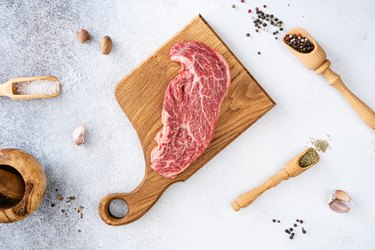
Meat can go bad for a wide variety of reasons. Rotten meat is likely to occur because of bacterial or fungal contamination, bad food hygiene, or simply leaving it at warm temperatures for too long. Regardless of the reason your meat has gone bad, you'll likely become sick if you eat rancid meat.
Tip
You can get sick from eating bad meat, even after cooking it. Certain bacteria produce toxins that can't be removed through heat.
Video of the Day
Identifying Rancid or Rotten Meat
Rancid meat is easy to identify. The USDA says that bad meat usually has a distinct scent and may even be discolored. The smell of rancid meat might remind you of sulfur or even ammonia.
Video of the Day
Red meat, like beef, has a naturally mild odor. It tends to smell sour when it begins to go bad. Fresh pork usually has a mild smell or no smell at all. When pork smells bad, the odor is much more obvious.
Rotten meat is more likely to have discolorations. Your meat may have a gray-green, brownish-green or green tint. If you see grey fuzz or green dots on the surface of your food, the USDA says that mold has likely grown throughout your meat.
The easiest way to tell if your meat is bad is to look at its texture. Fresh meat should be firm and moist. If your meat is slimy or sticky, this means that bacteria have likely started to multiply in the meat. Don't eat meat if you think it's rancid or rotten.
Food Poisoning and Symptoms
There are many different types of bacteria that can make your meat go bad. Bacterial contamination can come from the animal itself (usually their gut) or people, particularly when they haven't washed their hands before cooking. It's also possible for bacteria to come from unclean kitchen equipment.
Pathogenic bacteria such as salmonella, staphylococcus and E. coli are particularly likely to make you sick. The Mayo Clinic says that certain types of these bacteria can make you sick even when you consume them in small amounts.
If you eat meat that has been contaminated with these bacteria, you'll probably end up with food poisoning. According to the Mayo Clinic, food poisoning symptoms include nausea, vomiting, fever, abdominal pain and other gastrointestinal issues. Certain strains of pathogenic bacteria are known to cause bloody diarrhea. Food poisoning can last from a few hours to a few days.
Preventing Food Poisoning
Fresh meat should only be kept for a few days in the fridge. The US Food & Drug Administration recommends that you store most raw meats, including poultry, in your refrigerator for just a day or two. You can store certain fresh red meats, like beef, pork and lamb, in the fridge for up to five days.
If you leave meat in the refrigerator for longer than this, it will slowly start going bad. Fortunately, you can prevent your meat from going bad by freezing it. Meat can be kept in the freezer for up to 12 months.
The way you handle your meat prior to cooking it can also influence bacterial growth. According to the USDA Food Safety and Inspection Service, bacteria can multiply quickly at temperatures between 40 and 140 degrees Fahrenheit. Making sure that your meat spends minimal amounts of time at this temperature range can help prevent food poisoning.
The best way to prevent food poisoning is by cooking your meat thoroughly. Regardless of whether your meat is frozen or fresh, the U.S. Department of Health & Human Services recommends that you cook it to an internal temperature of 145 degrees F. Chicken is considered safe when it's been cooked to an internal temperature of 165 degrees F.
Unfortunately, you might still get sick even after you've thoroughly cooked your food and killed any bacteria. This is because of the toxins that certain bacteria release. These toxins can also produce food poisoning symptoms.
- Mayo Clinic: "E. coli"
- Mayo Clinic: "Food Poisoning"
- US Food & Drug Administration: "Refrigerator Freezer Chart from Food Safety for Moms to Be"
- US Department of Health & Human Services: "Meat and Poultry Charts"
- USDA Food Safety and Inspection Service: "Danger Zone"
- USDA: "Molds On Food: Are They Dangerous?"
- USDA: "The Color of Meat and Poultry"
Was this article helpful?
150 Characters Max
0/150
Thank you for sharing!
Thank you for your feedback!